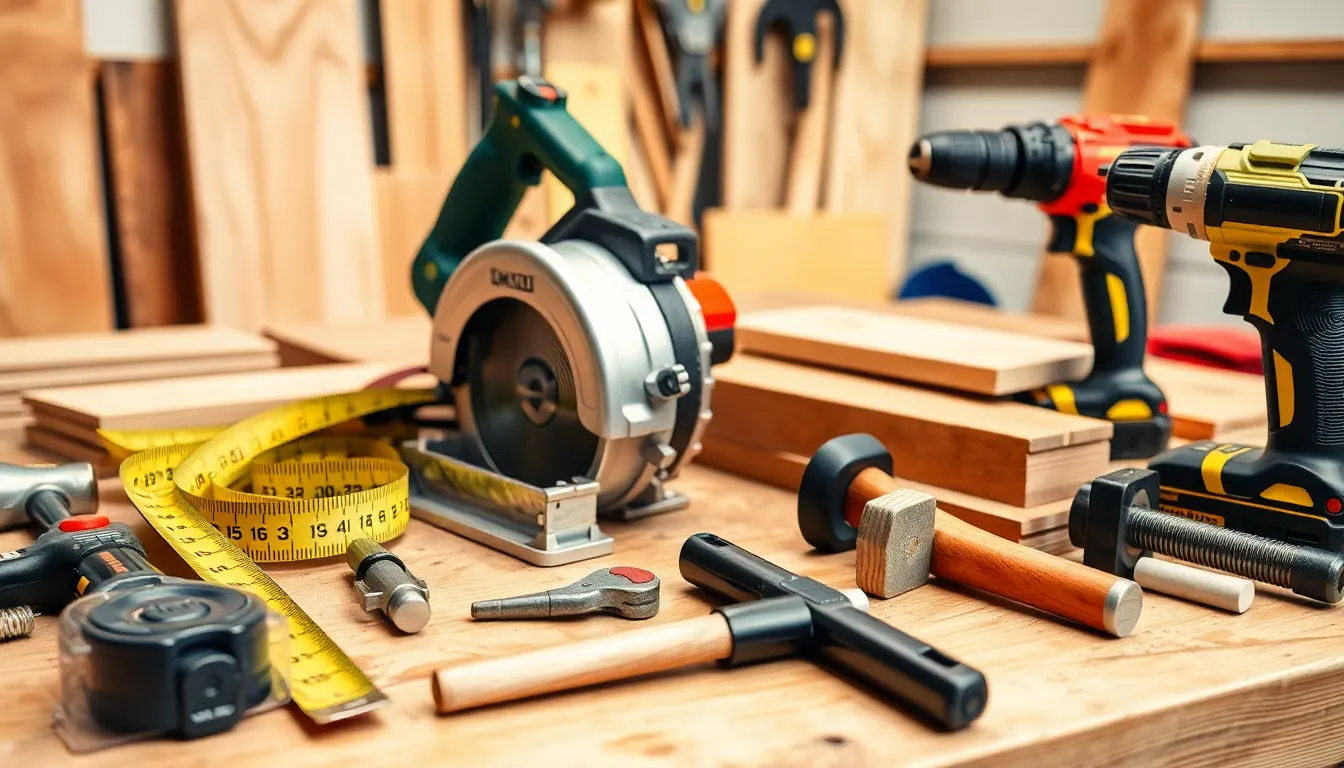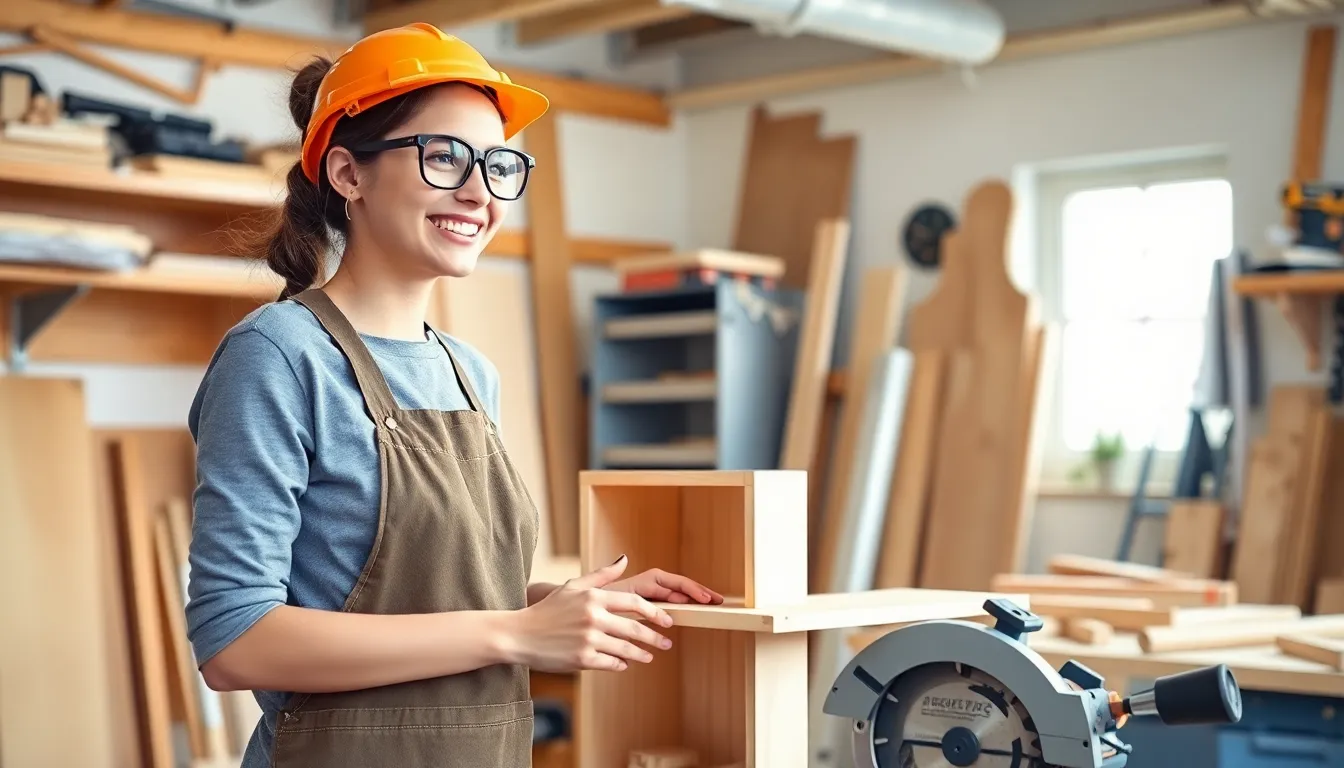Diving into DIY wood projects can feel like stepping onto a rollercoaster—exhilarating yet a bit daunting. But fear not! With just a few tools and a sprinkle of creativity, anyone can transform ordinary wood into extraordinary creations. Whether it’s crafting a chic bookshelf or a quirky planter, these easy projects are the perfect way to unleash inner artistry without needing a Ph.D. in carpentry.
Table of Contents
ToggleEasy DIY Wood Projects for Beginners
Creating wooden projects offers a fulfilling experience for beginners. Simple designs lead to the best results. Consider making a bookshelf. It requires only a few boards, screws, and basic tools. Start by cutting the wood to size and assemble with screws for stability.
Another great option is a planter box. This project enhances any outdoor space. With easy measurements for the sides, it’s simple to cut and join. Using wood screws ensures durability, allowing herbs or flowers to flourish.
Coasters also make excellent beginner projects. Materials are minimal; wood scraps work perfectly. Cut the wood into desired shapes, then sand and finish for a polished look. These coasters protect surfaces while showcasing creativity.
For a more functional piece, try a wall-mounted shelf. It combines simplicity and style. Measuring accurately allows for a perfect fit in any room. Assemble with brackets or screws to secure it firmly to the wall.
Lastly, create a key holder. This project adds practicality to entryways. Use a small piece of wood as the base and attach hooks for hanging keys. A quick coat of paint or varnish adds a personal touch.
Each project encourages experimentation and skill development. Completing these tasks provides not only satisfaction but also functional items for home use. With every effort, confidence in woodworking grows.
Essential Tools and Materials

Basic tools and materials form the foundation for successful DIY wood projects. Familiarity with these items ensures a smooth crafting experience.
Basic Tools Required
Measuring tape serves as a must-have for accuracy during cuts. A circular saw simplifies the task of cutting boards to size, while a hammer drives nails into place securely. Clamps hold pieces together firmly, preventing movement while gluing or screwing. Sandpaper eases rough edges for a smooth finish. A drill with various bits makes holes for screws and anchors, enhancing structural integrity. Safety glasses protect eyes from debris, promoting safe handling of tools and materials.
Wood Types to Consider
Pine stands out as an affordable and widely available option, perfect for beginners. Oak offers durability and a beautiful grain, making it suitable for furniture projects. Cedar presents natural resistance to rot, ideal for outdoor items like planters. Plywood provides strength and stability, particularly when creating larger objects. These wood types cater to various project requirements, ensuring successful and enjoyable building experiences.
Step-by-Step Guides for Popular Projects
Engaging in DIY wood projects promotes creativity and skill development. Here are guides for popular projects that encourage experimentation.
Simple Shelving Units
Creating simple shelving units involves basic cuts and assembly. Start with measuring desired shelf dimensions. Choose boards based on the weight they will support. Cut the boards using a circular saw and sand any rough edges. Next, secure the pieces using screws and a drill for added stability. Install brackets or mount directly to the wall for a polished finish. Select a stain or paint to enhance the overall look. These shelving units provide functional storage while offering a personal touch to any space.
Rustic Picture Frames
Making rustic picture frames adds charm to home decor. Collect old wood or reclaimed barn wood for a unique appearance. Measure your photographs to determine the frame size. Cut the wood pieces at right angles and join them with wood glue and clamps. Allow the glue to dry before sanding surfaces for smooth edges. Attach a backboard to hold the picture in place along with hanging fixtures. Paint or stain for added character. Rustic frames complement various styles, showcasing photos beautifully.
Garden Planters
Building garden planters creates beautiful greenery spaces. Decide the planter dimensions to fit your plant needs. Use rot-resistant wood like cedar for durability against weather elements. Cut the wood to specified lengths, sanding edges for safety. Assemble the planter with wood screws and ensure drainage holes at the bottom. Line the interior with landscaping fabric to keep soil intact. Fill with soil and desired plants to enhance your garden. Planters not only improve aesthetics but also promote gardening interests.
Tips for Successful DIY Woodworking
Successful woodworking hinges on preparation, safety, and skill enhancement. Following these tips can lead to satisfying outcomes.
Safety Precautions
Prioritizing safety ensures an efficient DIY experience. Wearing safety glasses protects the eyes from debris during cutting and sanding. Using ear protection when operating loud machinery prevents hearing damage. Keeping a clean workspace reduces the risk of accidents. Additionally, ensuring all power tools operate properly prevents malfunctions. Following the manufacturers’ guidelines for each tool enhances safety. Using clamps securely holds pieces while cutting, preventing unexpected slips. Remember that understanding basic first aid can be beneficial if an accident occurs.
Finishing Techniques
Finishing techniques significantly enhance the final look of woodworking projects. Sanding wood surfaces smoothens rough edges, improving aesthetics and safety. Applying primer before paint promotes even coverage and better adhesion. Choosing the right type of paint, whether water-based or oil-based, impacts durability and appearance. Staining wood can reveal its natural grain while providing protection. Sealing projects with a clear coat preserves the finish against wear over time. Applying finishes in thin layers allows for better control and prevents drips. Ensuring adequate drying time between coats results in a flawless finish.
Embarking on easy DIY wood projects opens up a world of creativity and satisfaction. With just a few basic tools and some imagination, anyone can transform simple materials into functional and stylish pieces for their home. Each project offers an opportunity to learn and grow in woodworking skills while adding personal touches to living spaces.
Safety and preparation are key to a successful experience. By following the right techniques and taking necessary precautions, DIY enthusiasts can ensure their projects turn out beautifully. Whether it’s a bookshelf or a planter box, the joy of crafting something with one’s own hands is truly rewarding. So grab those tools and start building; the possibilities are endless!



